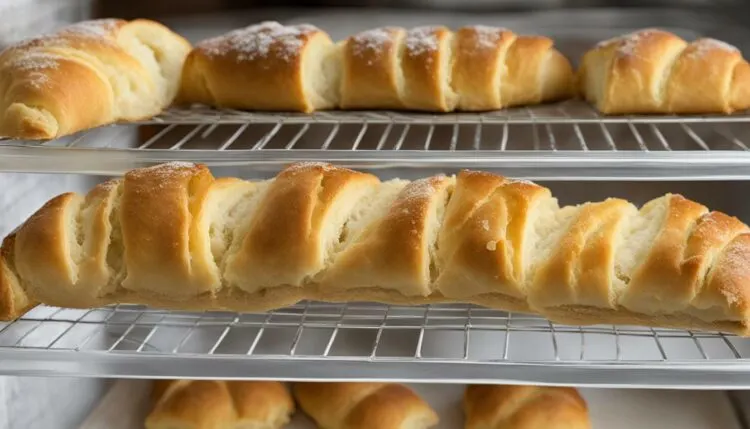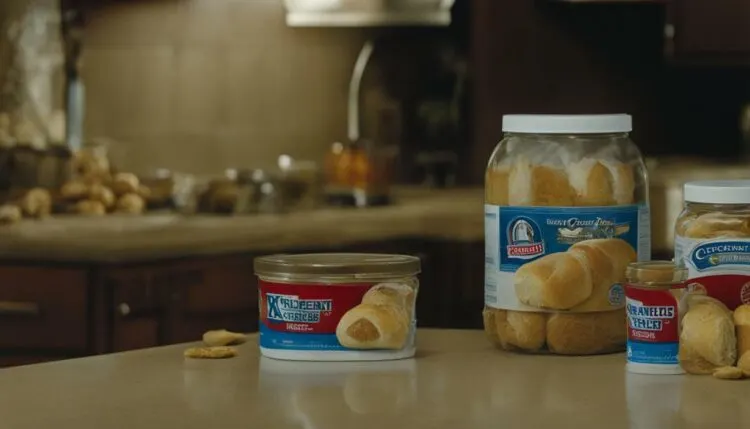If you’re like many people, you may have a package of crescent rolls sitting in your fridge that you forgot about. But now you’re wondering, are expired crescent rolls safe to eat?
The answer isn’t always a simple one. While some expired crescent rolls may still be safe to eat, others can pose risks to your health. Expired crescent rolls may pose risks due to potential spoilage or loss of quality. Check for signs of mold, unusual odor, or changes in texture. Consuming them past the expiration date can lead to foodborne illness. When in doubt, it’s safest to discard them to prevent health hazards.
We’ll explore how to determine if your expired crescent rolls are still safe to consume and discuss the potential risks associated with consuming spoiled dough.
Key Takeaways:
- Expired crescent rolls can sometimes be safe to eat, but it depends on the specific circumstances.
- It’s important to be aware of the signs of spoilage, such as changes in smell, texture, appearance or taste.
- Consuming expired crescent rolls can pose risks, including the risk of food poisoning.
- Proper safety measures, such as storing crescent rolls correctly and handling them carefully, can help prevent food poisoning.
- If in doubt, it’s best to err on the side of caution and discard expired crescent rolls.

Understanding the Expiration Date and Shelf Life of Crescent Rolls
It’s important to understand the expiration date and shelf life of crescent rolls to ensure that you’re consuming them when they’re still safe to eat. The expiration date is typically printed on the packaging and indicates the date by which the product should be consumed for the best quality.
However, it’s essential to note that the expiration date is not a hard and fast rule. The shelf life of crescent rolls can vary depending on factors such as storage conditions and exposure to heat and humidity.
According to the general rule of thumb, unopened crescent rolls can last up to three weeks beyond the printed expiration date if stored properly. Once opened, they should be consumed within seven days or frozen for later use.
However, it’s essential to use your judgment and assess the condition of the crescent rolls before consuming them past the expiration date. If the packaging is damaged, or the rolls have an off smell or appearance, it’s best to discard them.

If you’re unsure about whether or not crescent rolls are still safe to eat, check for signs of spoilage. The next section will outline the signs to look for in expired crescent rolls.
Signs of Spoilage in Expired Crescent Rolls
It can be challenging to determine whether crescent rolls have expired or not, especially when the expiration date on the package has passed. However, there are several signs of spoilage to look out for when handling expired crescent rolls. These signs can indicate that the rolls have become unsafe to eat and should be discarded.
One of the most evident signs of spoilage in expired crescent rolls is a change in smell. If the rolls have a sour, musty, or off-putting odor, it is likely that they have gone bad. Additionally, the texture and appearance of the dough can also indicate spoilage. If the dough has become slimy, sticky, or discolored, it may have been contaminated with bacteria and should not be consumed.
Another sign of spoilage is a change in taste. If the rolls taste bitter, acidic, or have an unusual flavor, it may indicate that the dough has been contaminated with harmful bacteria, making it unsafe to eat.
| Signs of Spoilage in Expired Crescent Rolls | Risks |
|---|---|
| Foul odor | Food poisoning and other health complications |
| Slime or stickiness | Infections and digestive issues |
| Discoloration | Stomach pains, diarrhea, and vomiting |
| Unusual taste | Dehydration, abdominal pain, and vomiting |
Consuming expired crescent rolls comes with several risks, including food poisoning and other health complications. The table above summarizes the signs of spoilage in expired crescent rolls, as well as the potential risks associated with consuming them.
It is crucial to be cautious when handling expired crescent rolls and to understand the signs of spoilage. Consuming contaminated dough can lead to severe health issues, including infections, digestive issues, dehydration, and abdominal pain. Therefore, it is recommended to discard expired crescent rolls once they show any signs of spoilage.

Consuming expired crescent rolls can pose various risks to your health. The dough in crescent rolls contains yeast, which can cause food poisoning when it spoils. Eating expired crescent rolls can lead to food poisoning, which can cause symptoms such as nausea, vomiting, diarrhea, and stomach cramps. In severe cases, food poisoning can even lead to hospitalization.
The risks associated with consuming expired crescent rolls are heightened for vulnerable groups such as young children, the elderly, and individuals with weakened immune systems. If you belong to any of these groups, it is especially important to be cautious when it comes to expired crescent rolls.
It’s also important to note that the risks associated with consuming expired crescent rolls aren’t limited to food poisoning. Consuming expired crescent rolls can also lead to other health complications, such as allergic reactions, if the dough has become contaminated with allergens such as nuts or soy.
Overall, it is essential to be aware of the risks associated with consuming expired crescent rolls. It is always better to be safe than sorry, so if you have any doubts about the safety of your crescent rolls, it’s best to err on the side of caution and discard them.

Proper handling and storage of crescent rolls can help to prevent spoilage and ensure their safety for consumption. Follow these safety measures and best practices when working with crescent rolls:
Storage
Store crescent rolls in their original packaging in the refrigerator until ready to use. If the package has been opened, tightly seal any unused rolls in plastic wrap or an airtight container. Avoid storing crescent rolls at temperatures above 40°F or in areas with high humidity, as this can lead to spoilage.
Handling
When handling crescent rolls, be sure to wash your hands thoroughly before and after working with the dough. Keep all surfaces and utensils used in the preparation of crescent rolls clean and sanitized to prevent contamination. If using a rolling pin, lightly coat it with flour to prevent the dough from sticking.
Extending Shelf Life
If you have extra crescent rolls that you don’t plan to use right away, you can freeze them for later use. Simply wrap them in plastic wrap and place them in the freezer. When ready to use, allow the rolls to thaw in the refrigerator overnight before baking.
Safety Measures for Other Dough Products
The safety measures outlined above also apply to other dough products, such as cookie dough and self-rising flour. When working with these products, be sure to follow the storage and handling instructions on the packaging. In addition, when using hydrogenated palm oil in baking, be sure to use it in moderation, as excessive consumption of palm oil can lead to health problems.
By following these safety measures and best practices, you can enjoy delicious crescent rolls without compromising your health or safety.
It’s essential to take expired crescent rolls seriously. While some expired crescent rolls may still be safe to eat, there are potential risks associated with consuming spoiled dough. It’s crucial to understand the signs of spoilage and assess the potential health risks before consuming expired crescent rolls.
To guarantee food safety, it’s essential to handle crescent rolls correctly. This includes storing them in the right conditions and using proper handling techniques. By ensuring that crescent rolls are stored appropriately, you can extend their shelf life and reduce the chances of spoilage.
It’s worth noting that these safety measures apply not only to crescent rolls but also to other dough products, such as cookie dough and self-rising flour. Additionally, it’s essential to check the ingredients in crescent rolls, including hydrogenated palm oil, for potential health risks.
In summary, practicing food safety is crucial when it comes to crescent rolls and other dough products. By understanding the signs of spoilage, assessing risks, and following safety measures, you can prevent food poisoning and other health complications. When in doubt, it’s always best to discard expired crescent rolls to avoid the potential dangers of consuming spoiled dough.
FAQ
How do I know if crescent rolls have expired?
Crescent rolls typically have an expiration date printed on the packaging. However, it is essential to understand that the expiration date is a guideline, and the actual shelf life may vary. Signs of spoilage to look out for include changes in smell, texture, appearance, and taste. If the crescent rolls exhibit any of these signs, it is best to discard them.
What are the risks of consuming expired crescent rolls?
Consuming expired crescent rolls can pose various risks, including the potential for food poisoning. Eating spoiled dough can lead to gastrointestinal issues such as nausea, vomiting, diarrhea, and stomach cramps. In severe cases, it can even cause more serious complications. It is essential to understand these risks and prioritize food safety.
How should I handle and store crescent rolls to ensure safety?
To ensure the safety of crescent rolls, it is crucial to handle and store them correctly. Store them in a cool, dry place away from direct sunlight and any sources of heat. Follow the storage instructions provided on the packaging. Additionally, always wash your hands before handling the dough, use clean utensils, and avoid cross-contamination. These measures help prevent the growth of harmful bacteria and maintain the quality of the crescent rolls.
Can I extend the shelf life of crescent rolls?
While crescent rolls have a limited shelf life, there are some measures you can take to extend it. Properly sealing the package after opening, storing them in the refrigerator, and following the manufacturer’s instructions for storage and usage can help prolong the freshness of crescent rolls. However, it is still essential to regularly check for signs of spoilage and use your judgment when determining if they are safe to eat.
Are the safety measures the same for other dough products?
While similar principles apply, it is important to note that different dough products may have specific considerations. For example, cookie dough should typically be refrigerated and handled with care due to the raw egg content. Self-rising flour and ingredients like hydrogenated palm oil may also have specific storage requirements. Always refer to the product packaging and follow the instructions provided to ensure optimal safety and quality.
- Crescent Roll Origins: Which Country Created It? - February 21, 2024
- What is the Origin of the Name Crescent Rolls? - February 21, 2024
- Are Pillsbury Crescent Rolls a Good Substitute for Puff Pastry? - February 21, 2024
